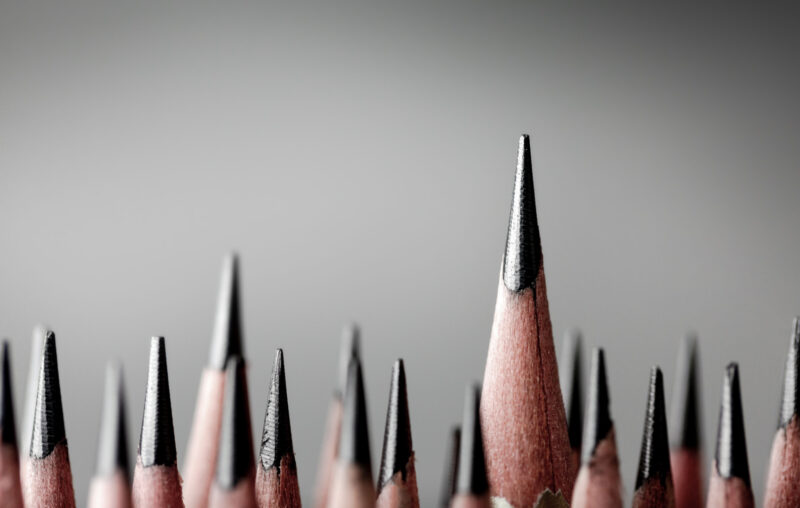What is a Pencil?

Many readers are familiar with Leonard Read’s classic essay “I, Pencil,” which shows how the market process facilitates cooperation amongst myriad individuals to produce simple items like a wood pencil.
Echoing Hayek, Read argues that markets, price signals, and the discipline of profit and loss are wonderful because they coordinate individuals and their myriad behaviors, values, and goals. Bastiat famously recognized this when he noted that people in Paris get fed. Hayek uses the phrase “marvel” to make the point. These arguments largely indicate the importance of dispersed knowledge and the difficulty—if not the futility—of central planning.
These are important lessons to be sure, but there is another lesson that often goes unnoticed. What is a pencil? Which characteristics define what a pencil is? Read makes a neat rhetorical move and focuses the reader’s attention on a simple wooden pencil with a graphite core. While Read’s choice motivates his essay, he presumes that we know what a pencil is to begin with. This seemingly simple issue belies additional complexities that further demonstrates the importance of dispersed knowledge that Read and most don’t recognize.
The market process not only facilitates the production of goods like a pencil—and more complex goods of course—it helps define them.
Should a pencil be made out of wood? Should it be seven and a half inches or five inches? Should it have a graphite core or one made out of lead? The answers to such questions vary across people; different people have different values and different answers. Some people might want wooden pencils that are more durable than pencils made of wax or textiles. Some people might want longer pencils that can be used for longer periods of time. Some people might want graphite pencils that leave darker markings.
The characteristics of a pencil will eventually depend on the opportunity costs consumers and producers face. Some buyers might be willing to pay for a gold-plated pencil and forego other goods; but not many to be sure. Some producers might be willing to hire dozens of workers and related machinery to combine the requisite materials in a factory.
All in all, the market for pencils coordinates the myriad decisions of buyers and sellers and accounts for these subjective individual evaluations and costs. In this way, the market process selects for the characteristics that make most buyers and sellers better off. A pencil emerges through a market process. People might use graphite sticks for a while, but they might switch to the more durable wooden pencils once available. Thus, a pencil becomes a rounded wooden stick with a graphite core, approximately seven inches long, with a piece of rubber attached on the end.
The history of the pencil and its varied antecedents clarifies this point. Prior to the “pencil” people had many instruments they could use to write, for example, their fingers, styluses made of reed, bone, quill, metal, and eventually graphite cores. Whereas ancient Egyptians used reeds, Romans used thin metal styluses. With the discovery of graphite in the 16th century, graphite cores—often wrapped with string—were more commonly used. And then there are crayons and their forerunners like pieces of charcoal.
The pencil became more or less standardized after the Industrial Revolution, the ground-breaking era in western Europe and in North America where commercial activity became prudent and praise-worthy (As McCloskey points out in her bourgeois project). In their efforts to earn profit via voluntary production and exchange, prominent pencil makers like Faber-Castell in Nuremberg and the Dixon Ticonderoga Company in the US began making pencils in the middle 19th century. These pencils satisfied many of the values people cared about: They were easy to use, durable, and the price encouraged exchange. They produced pencils on the margins disparate individuals valued, and those pencils became the standard.
Today pencils are manufactured with similar characteristics by firms like Faber-Castell on a scale that would mesmerize the likes of Adam Smith.
The overall lesson is that we would not commonly think of pencils as such without the market process and the myriad interactions between buyers and sellers. James Buchanan makes a similar point in his short essay, “Order Defined in the Process of its Emergence.” The spontaneous order produced in a market or, in this case, the outcome of a market process that standardizes what a pencil means, is only defined as the process unfolds. The pencil (order) is defined in the process of the pencil’s emergence.
Just as “I, Pencil” forces us to consider the myriad applications beyond pencils, there are myriad ways in which the market process produces and standardizes the products we consider valuable. From cars to metered dose inhalers and from iphones to eyeglasses, the market process clarifies the things we use.










